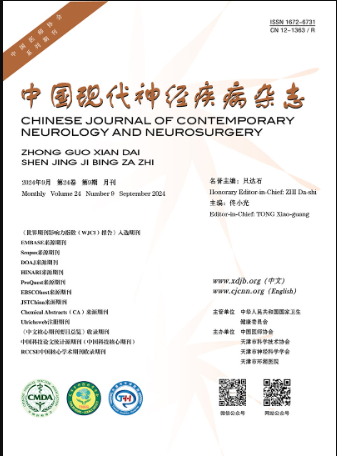The imaging characteristics and nasal endoscopic repair surgery for delayed postoperative cerebrospinal fluid rhinorrhea in patients with pituitary tumor
Q4 Medicine
引用次数: 0
Abstract
Objective To investigate the imaging characteristics and nasal endoscopic repair surgery for delayed postoperative cerebrospinal fluid (CSF) rhinorrhea in patients with pituitary tumor. Methods From June 2009 to November 2014 there were 23 cases with delayed CSF rhinorrhea in our hospital, which occurred one year to 5 years after the operation for pituitary tumor. Pituitary hormone assay, head MRI, cisternal CT and nasal endoscopic examination were performed in all patients. After definite diagnosis the patients underwent nasal endoscopic repair surgery of CSF rhinorrhea. During the operation, large leakage orifices were packed with muscle, and then patched with xenogenic acellular dermal matrix, while the small ones were directly patched with xenogenic acellular dermal matrix after tumor resection, and the sphenoid sinus was packed with gelatin sponge and iodoform gauze. Results Patients were hospitalized for 3 to 5 weeks. Among them, 20 patients were successfully recured after one nasal endoscopic repair surgery, 2 underwent the second surgery, and one underwent the third surgery. Patients were followed up for 3 months to 5 years with no CSF rhinorrhea reoccurred. Conclusions Delayed postoperative CSF rhinorrhea in patients with pituitary tumor were likely due to residual tumor growth and postoperative radiotherapy. Pituitary tumor often occur in sella, thus nasal endoscopic resection and repair surgery is feasible in treatment. The surgery is safe and the success rate is high. DOI: 10.3969/j.issn.1672-6731.2017.09.012垂体瘤术后迟发性脑脊液鼻漏的影像学特点及鼻内镜修复手术
目的探讨垂体瘤术后迟发性脑脊液(CSF)鼻漏的影像学特点及鼻内镜下修补术。方法自2009年6月至2014年11月,我院共有23例垂体瘤术后1年至5年出现迟发性脑脊液鼻漏。所有患者均进行了垂体激素测定、头部MRI、脑池CT和鼻内镜检查。在明确诊断后,患者接受了鼻内镜下脑脊液鼻漏修复手术。术中用肌肉填塞大的渗漏口,然后用异种脱细胞真皮基质进行修补,而小的渗漏口在肿瘤切除后直接用异种无细胞真皮基质修补,用明胶海绵和碘仿纱布填塞蝶窦。结果住院3~5周。其中,20例患者在一次鼻内镜修复手术后成功复发,2例患者接受了第二次手术,1例患者进行了第三次手术。患者随访3个月至5年,无脑脊液鼻漏复发。结论垂体瘤患者术后迟发性脑脊液鼻漏可能是由于肿瘤残留生长和术后放疗所致。垂体瘤多发于鞍区,鼻内镜下切除修复手术是可行的治疗方法。手术安全,成功率高。DOI:10.3969/j.issn.1672-6731017.09.12
本文章由计算机程序翻译,如有差异,请以英文原文为准。
求助全文
约1分钟内获得全文
求助全文

 求助内容:
求助内容: 应助结果提醒方式:
应助结果提醒方式:


